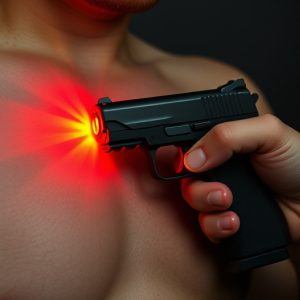Stun Gun Safety and Efficacy: Direct Contact, Legal Use, and Responsible Ownership
Stun guns are personal defense devices that deliver an electrical current to incapacitate an attack…….
Stun guns are personal defense devices that deliver an electrical current to incapacitate an attacker upon direct contact with their skin. Contrary to some misconceptions, they cannot function effectively from a distance without making physical contact. The electrical charge they emit disrupts muscle and nerve functions, causing a loss of balance and control. For effective use, individuals must be trained in the proper application and limitations of stun guns, including how to handle them safely and understand their physical and physiological effects. While some advanced models may offer features that can deter an assailant at a distance, most require direct contact with the skin for optimal performance. It's important to follow legal guidelines for possession and use, which vary by jurisdiction and include background checks and secure storage. Safety protocols must be observed to prevent misuse or injury, and users should always have an escape plan in case the device fails to subdue the threat. Regular training with the stun gun is essential for confident handling under pressure. Keywords: stun gun use, skin contact requirement, safety guidelines, legal compliance, personal defense tool, incapacitation effects.
When considering personal safety devices, stun guns stand out for their incapacitating effect. This article delves into the safe and effective use of stun guns, addressing common queries such as “Does a stun gun have to touch skin to work?” We explore the efficacy of stun guns, provide best practices for handling and deployment, and outline crucial legal considerations for responsible ownership. Understanding these aspects ensures users can rely on their stun guns when safety is paramount.
Understanding Stun Gun Efficacy: The Importance of Direct Contact
When considering the effectiveness of a stun gun for personal defense, understanding its operation is crucial. A common question regarding their use is whether physical contact with the target is necessary for a stun gun to be effective. The answer is affirmative; the device must make direct contact with an individual’s skin to deliver its incapacitating shock. This contact allows the electrical current to pass through the subject, disrupting the normal functioning of their muscles and nerves, which in turn causes a loss of balance and motor control, effectively deterring or neutralizing a threat. It’s a misconception that stun guns can be effective from a distance without touching the target; their design requires skin-to-skin contact to work as intended. Users should ensure they are trained in the proper application of a stun gun and understand its limitations, such as range and the importance of direct contact, to maximize safety and efficacy during an encounter. Proper technique involves holding the stun gun firmly against the assailant’s body while activating it, which ensures that the electrical charge is delivered directly and effectively. By doing so, users can significantly reduce the risk of an attacker continuing their aggression.
Safe Handling and Deployment: Best Practices When Using a Stun Gun
When deploying a stun gun for self-defense, safe handling is paramount. It’s crucial to familiarize yourself with the device before an encounter, ensuring you understand its operation and potential effects. One common question regarding stun guns is whether they need direct contact with the skin of an attacker to be effective. While many stun guns require skin-to-skin contact for optimal delivery of the electrical charge, some models may have drive stun capabilities that can incapacitate an assailant from a greater distance. Regardless of the model, it’s essential to maintain a safe distance and consider the legal implications and ethical responsibilities before using a stun gun in any situation.
Proper deployment begins with a firm grip, allowing for precise aiming and control during use. Always ensure that you are in a position to escape or defend yourself should the stun gun not incapacitate the threat. When using the device, avoid pointing it towards your own body or towards sensitive areas, as the electrical current can affect the user as well. Additionally, practice and training with the stun gun are vital for confident handling under stress. Regularly review safety protocols and legal guidelines to ensure responsible use. Always remember to follow local laws and regulations regarding the possession and use of stun guns, as they can vary significantly from one jurisdiction to another.
Legal Considerations and Responsible Ownership of Stun Guns
When considering the legal aspects and responsible ownership of stun guns, it’s crucial to understand the laws that govern their use and possession in your jurisdiction. Stun guns are electronic devices designed to incapacitate an assailant by delivering a high-voltage, low-ampere electrical shock. They serve as a non-lethal means of self-defense for many individuals. A common question regarding stun gun efficacy is whether direct contact with the skin is necessary for the device to be effective. In most cases, stun guns do not need to directly touch the skin to deliver their shock; they can incapacitate through intermediate objects like a barrier or clothing, thanks to their design. However, this feature can vary by model, so it’s essential to consult the manufacturer’s specifications for accurate information on each device’s capabilities.
Responsible ownership of stun guns extends beyond understanding their operation and capabilities; it also involves adhering to legal guidelines. These guidelines may differ by state or locality, emphasizing the importance of familiarizing oneself with the laws where the stun gun is carried and used. Proper storage to prevent unauthorized access is a critical aspect of responsible ownership. Additionally, individuals must undergo a background check in many places before purchasing a stun gun, ensuring that they are not prohibited from owning such devices due to their criminal history. It’s also imperative to handle stun guns with care, as misuse can lead to serious injury or legal consequences. Always ensure compliance with local laws and regulations to avoid any legal repercussions associated with the improper use of a stun gun.


